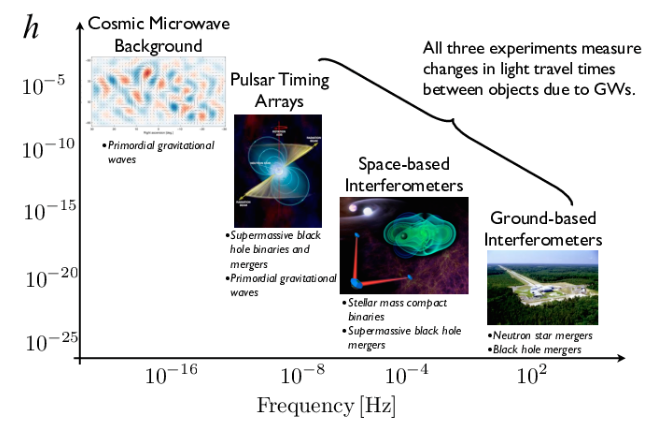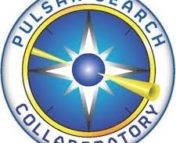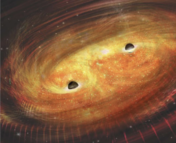Authors: K. Aggarwal, Z. Arzoumanian, P. T. Baker, A. Brazier, et al.
Corresponding Author: S. Vigeland
Status: Submitted to ApJ; open access on ArXiv
Disclaimer: I am part of the NANOGrav collaboration and my advisor is on the author list, but I am not directly involved in the gravitational wave detection efforts.
When people think of gravitational wave detection, they usually think of LIGO, the giant interferometer that has successfully detected gravitational waves multiple times from merging black holes and merging neutron stars. However, there is another global collaboration that aims to detect gravitational waves using a different method. NANOGrav, or the North American Nanohertz Observatory for Gravitational Waves, is part of a worldwide effort to detect gravitational waves using the times of arrival of light from massive neutron stars that act like lighthouses in the cosmos.
What are pulsars and how can we use them to detect gravitational waves?
Pulsars are massive, spinning neutron stars that emit radiation that sweeps across our line of sight like a lighthouse. With periods ranging from milliseconds to ~10 seconds, millisecond pulsars are such stable rotators that they rival the accuracy of atomic clocks. For this reason, NANOGRav is most interested in these more rapidly rotating pulsars. The collaboration “times” pulsars, or observes them frequently in order to figure out precisely how often they tick. The times of arrival (“TOAs”) of individual pulsars are collected regularly and combined into one big data set. If a gravitational wave passes between us and a pulsar, it will change the time the pulse gets to us very slightly; as the gravitational wave travels toward us, it will cause us to see the pulse a little bit sooner than expected. Complex timing models have been created that predict/describe exactly when a pulse should arrive, and those models take into account things like proper motion, delays by the interstellar medium, and the pulsar’s spin period. By collecting years and years of data from pulsars all around the sky, the NANOGrav collaboration can comb through the TOAs to look for gravitational wave signatures.
How are detections of gravitational waves with pulsars different than what we see with LIGO?
The main difference between LIGO and PTAs is the frequency of gravitational waves they are able to detect, as they are sensitive to different astronomical emitters. As seen in Figure 1, LIGO is sensitive to gravitational waves with a frequency of hundreds of Hertz which come from neutron star and black hole mergers. Pulsar timing arrays (PTAs) are sensitive to a different frequency of gravitational waves (at the nanohertz level) and these come from supermassive black hole binaries (SMBHBs), along with primordial gravitational waves (gravitational waves that occurred early in the universe’s history and are a consequence of inflation).

Figure 1: Different frequency ranges that can be observed by different instruments.
Credit: NANOGrav
NANOGrav uses the Green Bank Telescope (GBT) in West Virginia, the Arecibo Telescope in Puerto Rico (and also occasionally the Very Large Array in New Mexico) to observe millisecond pulsars. Over time, new pulsars are discovered and added to the data set and ones that prove to be less accurate for timing are eliminated. The data set used in this analysis includes 45 pulsars with observations made between 2004 and 2015 using Arecibo and the GBT.
What are “upper limits” and how do we get them?
If you are reading about gravitational wave detection then you will hear words like “frequency” and “strain.” The frequency of the gravitational waves is just the amount of gravitational waves per second; gravitational wave strain, which is usually abbreviated as h, is the relative change in distance between two masses as the gravitational wave passes between them. By doing searches for continuous waves (waves from individual sources instead of those just coming from an unresolved gravitational wave background) in the data set, the NANOGrav collaboration has put a limit on the strain of 7.3(3) x 10^15 at a frequency of 8 nHz (see Figure 2).

Figure 2: As more data have been gathered, the frequency of observations increases which means we have been able to probe down to smaller strains, as shown.
The minimum frequency of gravitational waves that we can find is calculated by taking the inverse of the total observing time (11.4 years), which turns out to be 2.8 nHz. The maximum frequency of gravitational waves is governed by how frequently pulsars are timed – since some pulsars are timed once per week, the team can detect frequencies up to 826.7 nHz. By collecting more data, they can lower this upper limit by getting to lower and lower strains (see Figure 3), and with other instruments that probe other frequencies, we can narrow down the range where these gravitational waves should be detected. After searching through 34 pulsars that had been observed for at least 3 years, the team found no evidence of gravitational waves in the TOAs in the 11-year data set.
What has NANOGrav found in this data set?
From the upper limits of strain, you can place a lower limit on the distance using the chirp mass (a quantity that relates to the masses of the two objects in the binary system) and the frequency of the gravitational waves. At the most sensitive sky location, we find that there are no SMBHBs with a chirp mass greater than 10^9 solar masses within a distance of 120 Mpc and none with chirp passes greater than 10^10 solar masses within 5.5 Gpc. We can also use PTAs to understand where gravitational waves are and are not coming from. This is particularly interesting because there are several galaxies nearby with SMBHB candidates. Using this data set, the collaboration has determined that there are no SMBHBs in the Virgo Cluster with a chirp mass greater than 1.6 x 10^9 solar masses emitting gravitational waves at a frequency of 9 nHz, which implies that none of the galaxies NGC 4472, NGC 4486, or NGC 4649 (which are all candidates for gravitational waves in the Virgo Cluster) could contain SMBHBs emitting gravitational waves in this frequency range. Therefore, this data set can not only tell us things about gravitational waves but also has astrophysical implications.
What does the future of PTAs look like?
NANOGrav continues to make improvements to the data analysis every day. New advanced software, such as PINT (for pulsar timing) and enterprise (for gravitational wave analysis), are improving the creation and analysis of pulsar timing array datasets. Observations of pulsars for timing purposes are being made by several pulsar timing array groups across the globe. These groups, in turn, work together in an effort to build the most robust collection of pulsar TOAs as part of the International Pulsar Timing Array collaboration. Current estimates expect gravitational waves to be detected from continuous wave sources within the next 10 years. NANOGrav is on the cutting edge of gravitational wave science, so keep your eyes (and ears) open for more news about the incredible science the collaboration is doing!

Figure 3: The position of each pulsar used in the data set. Lower and lower strains can be probed in sky locations with more pulsars because we can get a larger amount of data from that part of the sky. The most sensitive point on the sky is indicated by the red circle.




